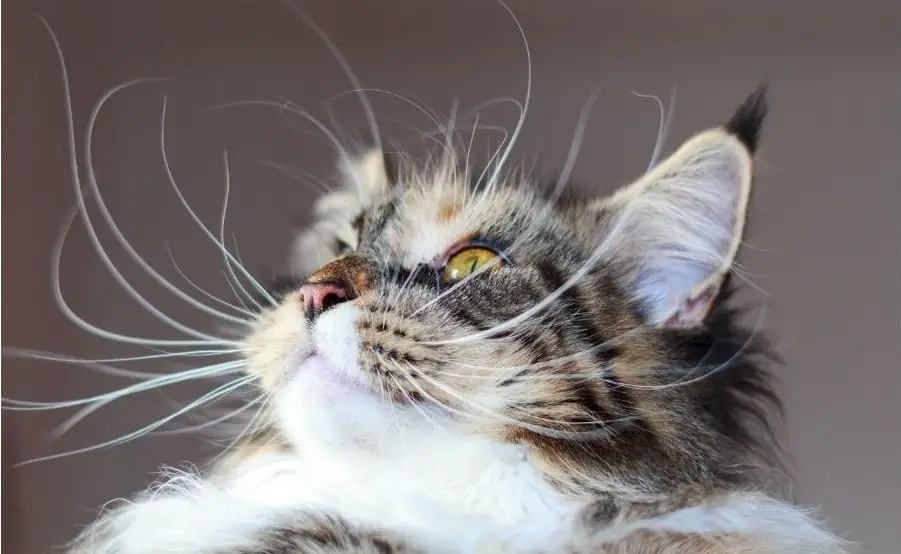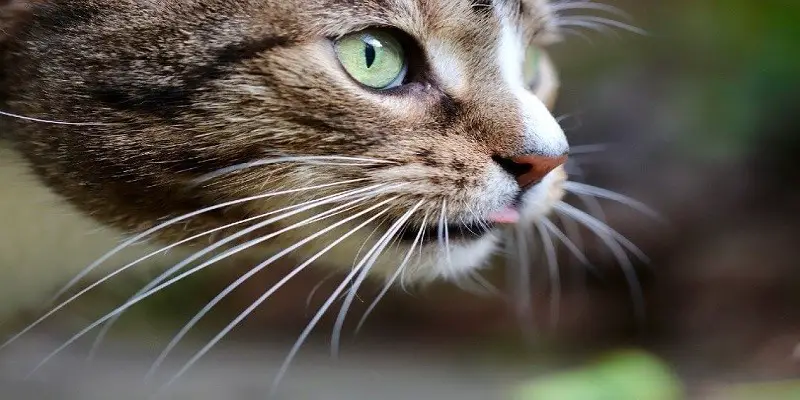Trimming cat whiskers is not recommended as they serve important sensory functions. Cat’s whiskers are highly sensitive to touch and help them navigate through their surroundings and communicate with other animals.
Cat owners often consider trimming their cat’s whiskers for various reasons such as aesthetic purposes, preventing whisker marks on food bowls or for safety concerns. However, it is essential to understand that cutting cat whiskers can be detrimental to their physical and emotional well-being.
In this article, we will delve into the reasons why cats have whiskers, their importance and the adverse effects of trimming them. We will also provide tips on how to ensure your cat’s whiskers remain healthy and protected.

Credit: www.catpointers.com
Reasons To Trim Cat Whiskers
Identification Of Reasons Why Some People Trim Their Cat’S Whiskers, Including Aesthetics And Behavior Modification
Cat owners often groom their pets to keep them looking their best. Many people believe that trimming a cat’s whiskers is harmless or even beneficial to their appearance. Some of the reasons why people might trim their cat’s whiskers include:
- Aesthetics
- Behavior modification
Explanation Of Why These Reasons Are Not Valid And May Harm The Cat’S Health And Overall Well-Being
While it is understandable that cat owners want their pets to look and behave their best, trimming their whiskers is not the solution. Here is why:
- Aesthetics: Some cat owners believe that trimming their cat’s whiskers makes them look neater or more attractive, but whiskers are an important part of a cat’s appearance. They add character and help the cat communicate and navigate its surroundings. Trimming them can cause stress and discomfort for the cat.
- Behavior modification: Some cat owners trim their cat’s whiskers to stop them from scratching or biting. However, this is a cruel and ineffective method. Whiskers are vital sensory organs that help a cat assess its surroundings and navigate. Trimming them can cause disorientation and anxiety, leading to more behavioral problems in the future.
Trimming a cat’s whiskers can harm its health and well-being. It is crucial to leave a cat’s whiskers intact, even though they may appear unruly at times. They are an essential part of a cat’s anatomy and should never be tampered with.
Consequences Of Trimming Cat Whiskers
Discussion Of The Adverse Effects Of Trimming Cat Whiskers
Cat whiskers, also known as vibrissae, are not just facial hair, but specialized sensory organs that play a crucial role in feline communication and physical orientation. Trimming them may sound like a harmless grooming routine, but the consequences can be disastrous.
Here are some of the adverse effects of trimming cat whiskers:
- Disorientation: Cats rely on their whiskers to detect the slightest changes in their surroundings. Whiskers help them determine the size, shape, and texture of objects, which is essential in providing spatial awareness and balance. Trimming whiskers can cause confusion, disorientation, and make it difficult for cats to navigate around their environment.
- Sensory deprivation: Feline whiskers are packed with nerve endings that are highly sensitive to even subtle vibrations in the air. These vibrations give cats a detailed, 3d sense of their environment, which they need for hunting, exploring, and interacting. Removing them can deprive cats of their primary source of sensory information, making them feel anxious and distressed.
- Behavior changes: Trimming cat whiskers can also alter their behavior, leading to aggression, fear, and depression. Without whiskers, cats can’t express themselves effectively and may become isolated, shy, or irritable.
Details On How Whiskers Help Cats In Their Day To Day Activities
Cats are natural hunters, and their whiskers play an essential role in their hunting skills. Here are some of the ways whiskers help cats in their day to day activities:
- Hunting: Whiskers help cats track and catch prey by sensing vibrations and movements in the air.
- Navigation: Whiskers help cats navigate their surroundings by detecting changes in air currents, temperature, and texture.
- Communication: Feline whiskers are also a vital part of their communication system. They use them to signal their mood, intent, and boundaries.
Trimming cat whiskers can hinder these abilities and cause cats to struggle with everyday activities that are crucial to their well-being.
Seo Friendly Heading With Keyword In A Relevant Context
Top reasons why trimming cat whiskers can have severe consequences for your feline friend
Trimming cat whiskers is not a simple grooming routine but has serious consequences on cats’ well-being and their ability to navigate and communicate. As responsible pet owners, we must understand the importance of these specialized sensory organs and avoid any unnecessary grooming practices that can harm our feline friends.
Alternatives To Trimming Cat Whiskers
A Rundown Of Alternative Grooming And Training Techniques To Alter Unwanted Cat Behavior Without Resorting To Trimming Whiskers
Cats are fascinating creatures equipped with amazing senses to help them navigate the world. Along with their adorable appearance, cats have unique and crucial sensory organs such as their whiskers. Many people believe that trimming their cat’s whiskers will make them look better, but this belief is not true.
Unfortunately, trimming a cat’s whiskers can cause discomfort and may affect their balance and cognitive abilities. However, there are alternative grooming and training techniques that can help alter unwanted behaviors without trimming your cat’s whiskers.
Highlighting Safe And Gentle Methods Of Keeping Cats Well-Groomed At Home
Keeping your cats well-groomed is an essential part of pet ownership, but it doesn’t have to come at the expense of their comfort and well-being. Here are safe and gentle methods for keeping your cat clean and groomed:
- Brushing: Brushing your cat’s fur regularly will help to distribute their natural oils and remove tangles and mats. Besides, brushing can reduce shedding and help to control hairballs.
- Scratching posts: Providing your cat with a scratching post is an excellent way to keep them from scratching your furniture or carpets. Plus, scratching posts can help to groom your cat’s claws.
- Nail trimming: Keeping your cat’s nails trimmed can prevent accidents and damage to your furniture. To trim your cat’s nails safely, use high-quality nail clippers and avoid cutting their quick.
- Bathing: Cats are clean animals and can groom themselves, but bathing can help to remove dirt, fleas, and reduce odors. However, make sure to use a cat-specific shampoo and avoid getting water in their ears and eyes.
Providing Helpful Resources And Contacts For Expert Advice On Cat Grooming And Care
Cats are complex animals, and grooming them can be tricky. If you’re unsure about how to groom your cat, it’s always best to consult with a veterinary professional or a cat groomer. Some helpful resources and contacts for expert advice on cat grooming and care include:
- The american society for the prevention of cruelty to animals (aspca): The aspca has a comprehensive guide to cat grooming with helpful tips and techniques for keeping your cat healthy and safe.
- International cat care: This organization has a wealth of information on cat behavior and care. They also offer courses on cat care for feline enthusiasts and veterinary professionals.
- Your local veterinary clinic: Your veterinarian can provide expert advice on cat grooming, including tips on how to trim your cat’s nails and bathe them safely.
Trimming a cat’s whiskers should be avoided at all costs as it can cause your cat discomfort and negatively impact their welfare. Instead, utilize alternative grooming and training methods such as brushing, scratching posts, nail trimming, and bathing. Additionally, if you require expert advice on cat grooming and care, the aspca, international cat care, and your local veterinary clinic are all excellent resources to consult.
Frequently Asked Questions For Should You Trim Cat Whiskers?
Can You Trim Cat’S Whiskers At Home?
It is not recommended to trim a cat’s whiskers at home as they are crucial to their balance and sense of surroundings.
Do Trimmed Cat Whiskers Grow Back?
Yes, trimmed cat whiskers do grow back but it can take several months for them to reach their full length.
What Are The Consequences Of Trimming Cat Whiskers?
Trimming cat whiskers can cause disorientation, confusion, and affect their hunting and navigating abilities. It can also cause pain and discomfort.
Are There Any Medical Reasons To Trim Cat Whiskers?
No, there are no medical reasons to trim cat whiskers. In fact, it can cause more harm than good.
What Should I Do If My Cat’S Whiskers Are Too Long?
If your cat’s whiskers seem to be getting too long, there’s no need to worry. They will eventually shed and be replaced with shorter whiskers.
Conclusion
Cat whiskers are an essential part of cat anatomy and serve a vital function, providing sensory information and navigation to cats. Trimming cat whiskers is not recommended, as it can cause anxiety and disorient the cat. Cat owners should never underestimate the importance of cat whiskers and ensure that their cat’s whiskers are left untouched.
It is essential to keep in mind that a cat’s whiskers should always be respected and never cut. When it comes to cat care, a cat’s health and well-being should always be the top priority, and trimming cat whiskers should not be necessary.
By following these guidelines, cat owners can ensure that their feline friends lead a healthy, happy, and fulfilling life. Remember, a happy cat means a happy home!
Last Updated on January 14, 2025 by Pauline G. Carter

